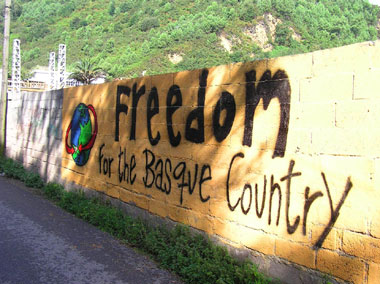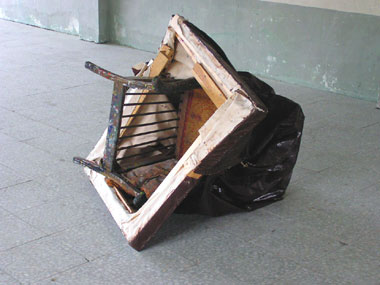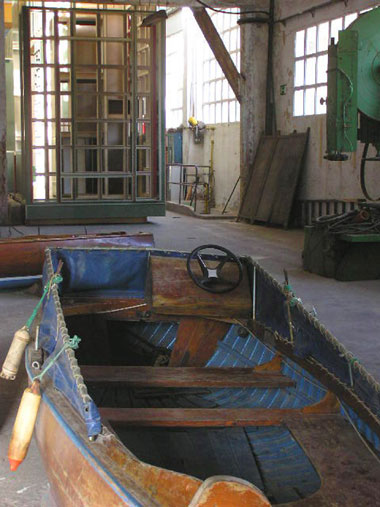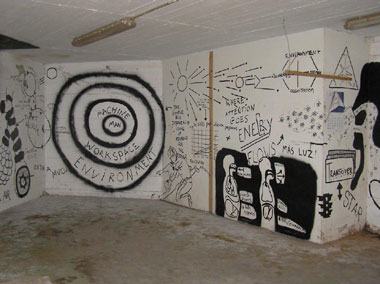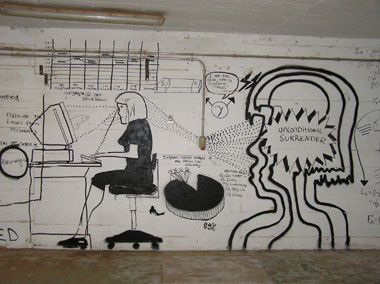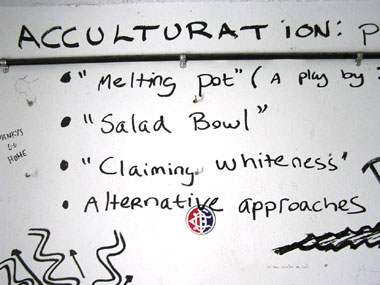Regina Gleeson discusses issues at the core of Manifesta 5 in San Sebastián.
Political rumour / cultural landscape / present imperfect / ruins in reverse / zones of contingency / under construction / spiritual noises / project and accusation / landscape manual / encounter with ambiguity / city folded over onto itself / two way mirror / double exposure / bipolar city / power of identity / potemkin village / staged matrix / trickland / silent factory – With All Due Intent ( Manifesta 5 concept and themes)
The doors have just closed on the fifth edition of the nomadic biennial of European Art, Manifesta . This year’s show was located in the Basque city of San Sebastián in the North of Spain, which is a beautiful location but also one that is alive and edgy with affirmations and tensions surrounding its cultural and sociopolitical autonomy. The location was chosen for what it could offer to Manifesta in terms of providing a context within which to consider the themes of the show. These themes, listed above, looked at some schizophrenic associations of architectonics and urban landscape and many individual works in the show were formed around the bipolarity between the utopia and dystopia of Home – separation from it, desire for, dispersal from, deconstruction of, familiar shape of and inescapable ties with Home.
Manifesta 5 does not shout about its brilliance or stomp its creative little feet in demand of our attention. It is an understated show, sincere in its portrayal of this moment in time. Marta Kuzma and Massimiliano Gioni have beautifully and skilfully curated the exhibition, attending to the minor details that can be the demise of many a show, such as attention towards avoiding the distractions of noise and light pollution, facilitating the audience with simple seating where necessary and affording each work the kind of capsule of space for which it had been intended. This is not an exhibition that rages against the machination of global structures but rather one that shows a collection of first-person-singular accounts of small moments that collectively offer a broad account of the psychogeography of contemporary Europe. Manifesta offers these unpretentious accounts of suffocation and survival within the mechanisms of the societies of these global times with all of the redefining of borders, bitter ironies and quirky contrasts.
The works exhibited use a sentient, coded language that functions on a delicate energy; one that had no need for grandeur or ceremony. David Zink Yi’s La Cumbia is a projected video showing the artist’s fingers dancing a solemn tango along the contours of his body and strongly suggests a difficult separation from the sounds, smells, rhythm and roots that the artist knows as Home. This lonely but sweet reverie shows something of the quiet idiosyncrasy we sometimes engage in when we think no one watches, such as when a pianist is waiting for someone and all the while dancing their fingers along the edge of the table as they mentally rehearse a piece of music. The work is a poignant expression of the reality of Home sweet Homesickness when one is in search of home in every other location.
The thread of a global suburbia that grows out of sprawling homes-from-home continues throughout the various exhibition venues, but a greater proportion of work relates to the situation of being grounded in the physical location of home whose roots simultaneously strangle and seduce. Carlos Bunga’s work, which expresses interest in urban spatial relationships in the light of rapid degradation of structures and objects, is shoulder-to-shoulder with Michael Sailftorfer’s installation, Breadboard construction Marilyn. This work operates on a transformation and displacement of form, function and concept. Laura Horelli’s Helsinki shipyard videos expose the background to the homes of those involved in the luxury-cruise-ship industry as being far removed from the opulence of the customers they serve. In contrast to Bunga’s work, these videos identify a commercial structure and its regime as home, even if that ‘home’ imposes impossible practical and lifestyle limitations on its inhabitants. Angela De La Cruz’s Clutter examines displacement of form in a deconstructionist exploration of formal physical structures. Leopold Kessler has made the simplest intervention in the city, and like many of the smallest, most precise efforts, has had a resounding effect. He has tilted the flow of one jet of water in a fountain and in doing so, has quietly drawn attention to the sharp edges of the over-planned uniformity of the city space. This is one of the most playful, unassuming and cleverly engaging works in the show.
The symmetrical, classical architecture and planning of central San Sebastián gradually gives way to functional high-rise flats and empty warehouses as one moves out of the city towards an area called Pasaia where Manifesta continues. Here, Jan De Cock has inverted the reflection of an empty disused ship-building warehouse inside itself. He has filled a hollowed-out redundant centre with multiple, super-exposures of itself, turning it into a structure that is a tri-dimensional Mondrianesque delineation of space.
The only participant from the Republic of Ireland is Garrett Phelan, whose work is also located off-site in an old harbour building. Contrary to its description on the art circuit’s grapevine, Phelan’s installation, LUNGLOVE, is not manic at all. It is certainly cluttered but orbits a specific concept regarding an exchange of energies in personal and collective existences that influence health and survival in and against the machine. Throughout the rooms his work occupies, the walls are covered with diagrams and words elucidating variations on the theme. The overwhelmingly dank smell that permeated the entire space prevented viewers from lingering. This was a great pity, as there were strong lines of thought that continued through the series of rooms that required a little time to be read and digested, but the heavy smell in the summer heat was a little too much for many viewers to fight against. The work’s content is suitable to this location, but one wonders at the omission of bi/tri-lingual texts. Phelan had considered using some translation in his text, but found that the spontaneity of process was interrupted in doing so. He also observed that, even though there are no obvious points of reference for San Sebastián as a location, this work has universal relevance and therefore could exist in any location. Phelan’s work was a good choice for this Manifesta, as it expressed nervousness in participation in the work machine which was a common thread in some of the other works on show. It is also relevant to all of us in an expanding Europe Union. It was interesting to see similar threads of tension in work from across the continent, irrespective of the strength of the economy and sociopolitical terrain of the artist’s nationality or country of residence.
The next exhibition, Manifesta 6, is to be held in Nicosia in Cyprus in 2006. Considering that the committee’s manifesto is to address (note: not redress) the balance between the North and South of Europe and bearing in mind our geographical, cultural, political and economic terrain, we might then consider whether or not Ireland could be a potential future location for this nomadic European show. Physically, we are dangling off the outer edge of Europe, but in social and economic terms we are within the range of Central European trends. However, it is Ireland’s cultural positioning that is the most interesting aspect to be considered with regard to its relevance for Manifesta . The connection with elements that might previously have been identified as typically Irish has lessened. The population is increasingly including new ethnicities, but our cultural production needs time to reflect this. It seems that we are in that intermediary period of change wherein the current position is vague and the direction is unknown. Probably, the most notable thing we could offer in response to Manifesta ‘s questions, regarding peripheries and balances, is a refrain of further questions that are at the core of what might loosely be described as contemporary Irish culture. We might ask what fuels the energies, challenges the identities, defines the relationship with the centres or enables functional imbalances within Europe and across the globe.
While we are very much part of the European Union’s political landscape, it is our fluctuating cultural landscape that would present the most fertile ground as a context for a future Manifesta . Some may consider that this lack of definition and direction reflects emptiness in the Irish culture of today but, in this instance, our supposed weakness could be our greatest strength, as the absence of definition allows diversity to thrive.
